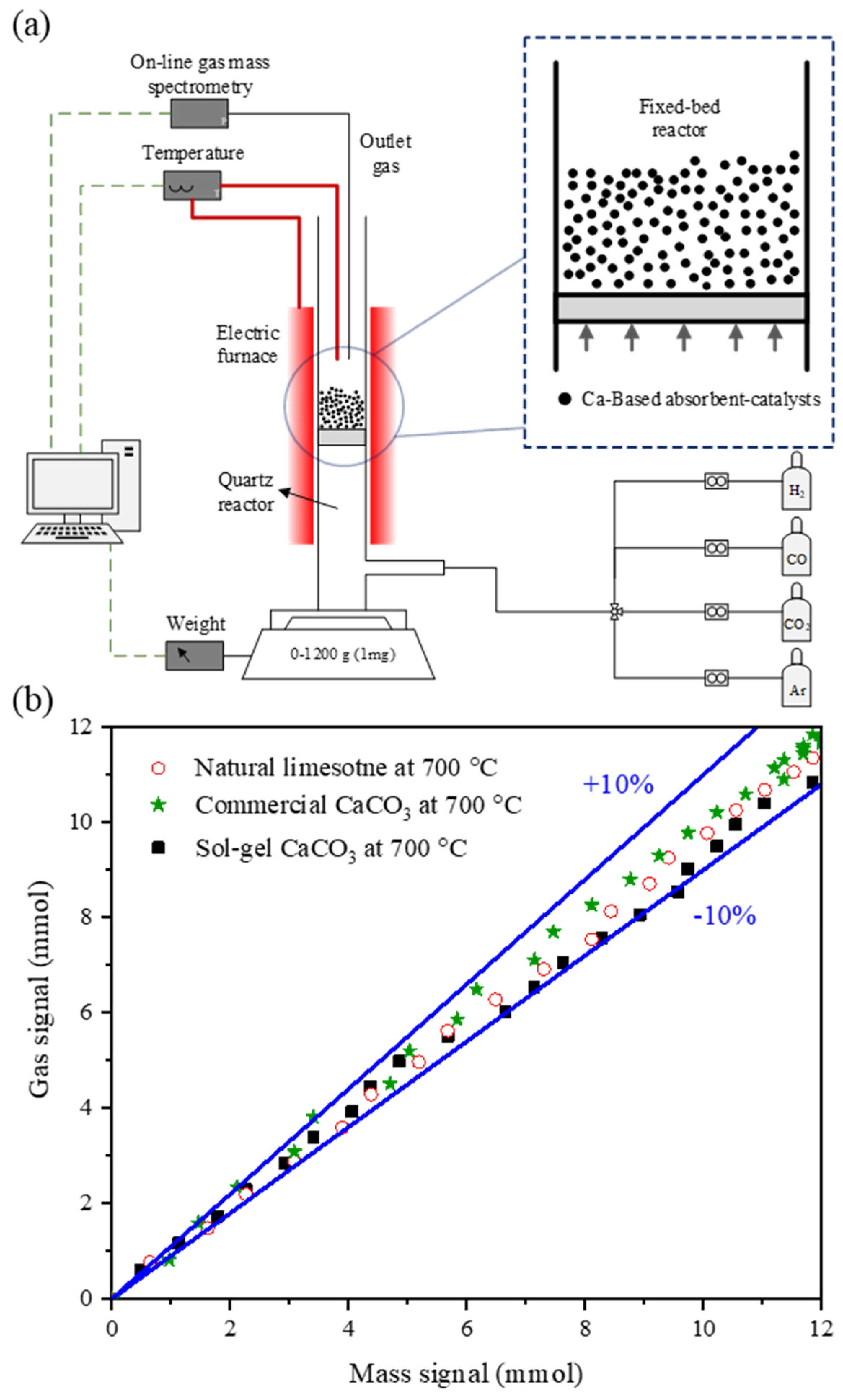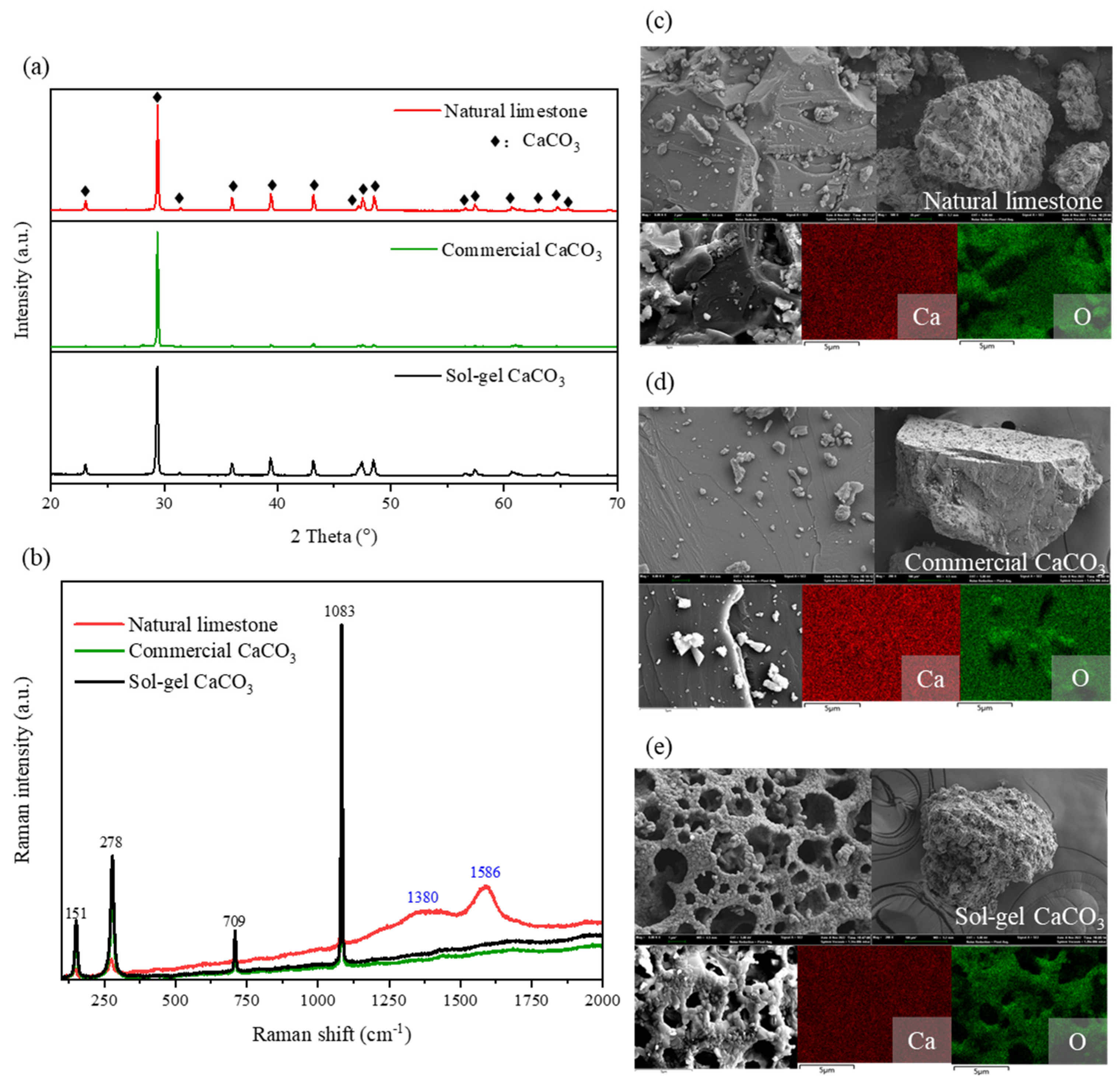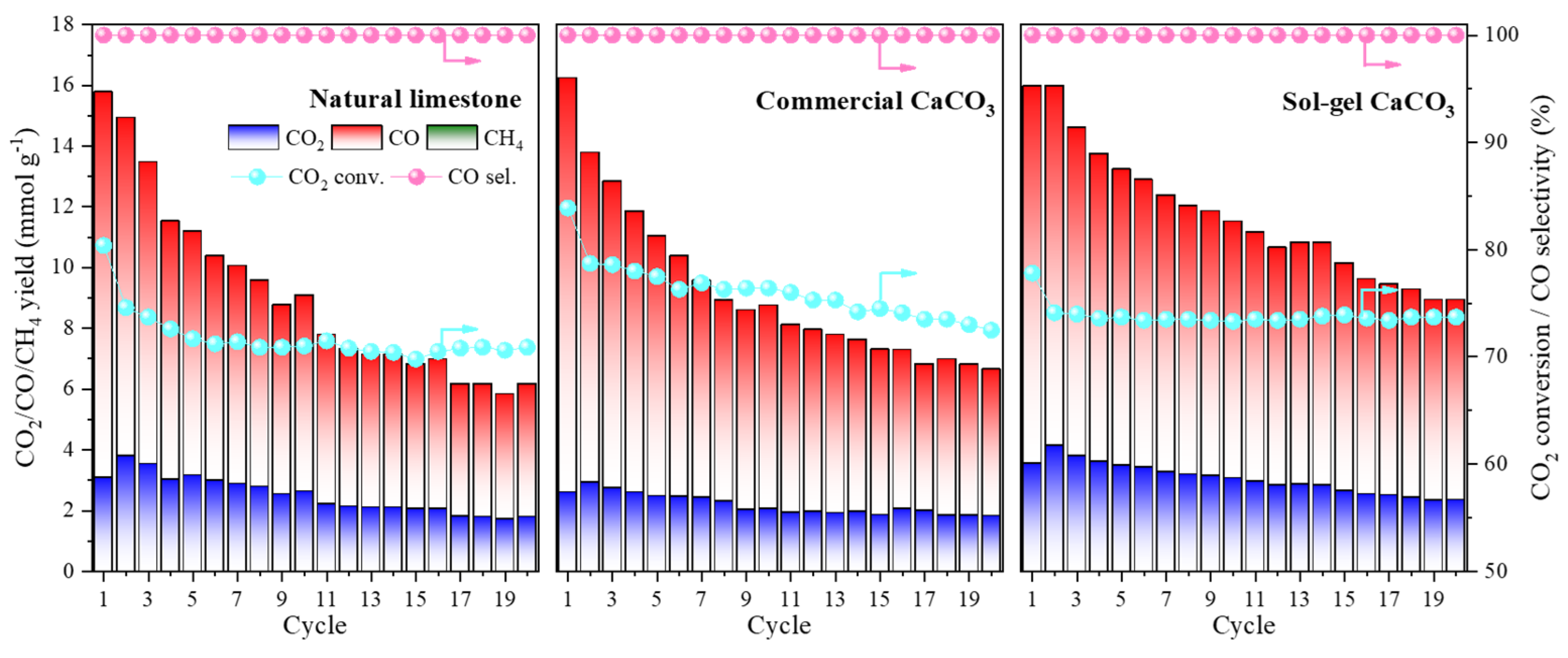Utilizing Limestone Alone for Integrated CO2 Capture and Reverse Water-Gas Reaction in a Fixed Bed Reactor: Employing Mass and Gas Signal Analysis
Abstract
1. Introduction
2. Experimental
2.1. Material Preparation
2.2. Material Characterization
2.3. Temperature Programmed Procedure
2.4. Integrated CO2 Capture and Utilization System
3. Results and Discussion
3.1. Phase and Structural Characterization of the Ca-Based DFMs
3.2. Integrated CO2 Capture and Utilization Performance of the Ca-Based DFMs
3.3. Cyclability of CO2 Capture and Utilization on Ca-Based DFMs
4. Conclusions
Supplementary Materials
Author Contributions
Funding
Data Availability Statement
Acknowledgments
Conflicts of Interest
References
- Rogelj, J.; Den Elzen, M.; Höhne, N.; Fransen, T.; Fekete, H.; Winkler, H.; Schaeffer, R.; Sha, F.; Riahi, K.; Meinshausen, M. Paris Agreement climate proposals need a boost to keep warming well below 2 C. Nature 2016, 534, 631–639. [Google Scholar] [CrossRef] [PubMed]
- Muslemani, H.; Liang, X.; Kaesehage, K.; Wilson, J. Business models for carbon capture, utilization and storage technologies in the steel sector: A qualitative multi-method study. Processes 2020, 8, 576. [Google Scholar] [CrossRef]
- Lv, Z.; Du, H.; Xu, S.; Deng, T.; Ruan, J.; Qin, C. Techno-economic analysis on CO2 mitigation by integrated carbon capture and methanation. Appl. Energy 2024, 355, 122242. [Google Scholar] [CrossRef]
- Chen, J.; Xu, Y.; Liao, P.; Wang, H.; Zhou, H. Recent progress in integrated CO2 capture and conversion process using dual function materials: A state-of-the-art review. Carbon Capture Sci. Technol. 2022, 4, 100052. [Google Scholar] [CrossRef]
- Jin, B.; Wang, R.; Fu, D.; Ouyang, T.; Fan, Y.; Zhang, H.; Liang, Z. Chemical looping CO2 capture and in-situ conversion as a promising platform for green and low-carbon industry transition: Review and perspective. Carbon Capture Sci. Technol. 2023, 10, 100169. [Google Scholar] [CrossRef]
- Fernández, J.; Sotenko, M.; Derevschikov, V.; Lysikov, A.; Rebrov, E.V. A radiofrequency heated reactor system for post-combustion carbon capture. Chem. Eng. Process. Process Intensif. 2016, 108, 17–26. [Google Scholar] [CrossRef]
- Ahmed, S.; Bibi, S.S.; Irshad, M.; Asif, M.; Khan, M.K.; Kim, J. Synthesis of long-chain paraffins over bimetallic Na–Fe0.9Mg0.1Ox by direct CO2 hydrogenation. Top. Catal. 2024, 67, 363–376. [Google Scholar] [CrossRef]
- Ahmed, S.; Irshad, M.; Yoon, W.; Karanwal, N.; Sugiarto, J.R.; Khan, M.K.; Kim, S.K.; Kim, J. Evaluation of MgO as a promoter for the hydrogenation of CO2 to long-chain hydrocarbons over Fe-based catalysts. Appl. Catal. B Environ. 2023, 338, 123052. [Google Scholar] [CrossRef]
- Qiao, Y.; Liu, W.; Guo, R.; Sun, S.; Zhang, S.; Bailey, J.J.; Fang, M.; Wu, C. Techno-economic analysis of integrated carbon capture and utilisation compared with carbon capture and utilisation with syngas production. Fuel 2023, 332, 125972. [Google Scholar] [CrossRef]
- Lv, Z.; Deng, T.; Gao, C.; Zheng, Y.; Wu, C.; Ran, J.; Qin, C. Promotion of active H-assisted CaCO3 conversion for integrated CO2 capture and methanation. Chem. Eng. J. 2024, 489, 151427. [Google Scholar] [CrossRef]
- Boukha, Z.; Bermejo-López, A.; De-La-Torre, U.; González-Velasco, J.R. Behavior of nickel supported on calcium-enriched hydroxyapatite samples for CCU-methanation and ICCU-methanation processes. Appl. Catal. B Environ. 2023, 338, 122989. [Google Scholar] [CrossRef]
- Sun, S.; Wang, Y.; Xu, Y.; Sun, H.; Zhao, X.; Zhang, Y.; Yang, X.; Bie, X.; Wu, M.; Zhang, C. Ni-functionalized Ca@Si yolk-shell nanoreactors for enhanced integrated CO2 capture and dry reforming of methane via confined catalysis. Appl. Catal. B Environ. Energy 2024, 348, 123838. [Google Scholar] [CrossRef]
- Li, J.; Gao, C.; Cheng, Y.; Lv, Z.; Qin, C. Solar driven integrated CO2 capture and CH4 dry reforming via FexMny/Ni/CaAl multi-function materials. Chem. Eng. J. 2024, 490, 151512. [Google Scholar] [CrossRef]
- Sun, S.; Zhang, C.; Guan, S.; Xu, S.; Williams, P.T.; Wu, C. Ni/support-CaO bifunctional combined materials for integrated CO2 capture and reverse water-gas shift reaction: Influence of different supports. Sep. Purif. Technol. 2022, 298, 121604. [Google Scholar] [CrossRef]
- Shao, B.; Hu, G.; Alkebsi, K.A.; Ye, G.; Lin, X.; Du, W.; Hu, J.; Wang, M.; Liu, H.; Qian, F. Heterojunction-redox catalysts of FexCoyMg10CaO for high-temperature CO2 capture and in situ conversion in the context of green manufacturing. Energy Environ. Sci. 2021, 14, 2291–2301. [Google Scholar] [CrossRef]
- Wang, I.; Cai, J.; Wang, S.; Li, Z. Uncovering hydrogen-to-carbon ratio for integrated CO2 capture and reverse water-gas shift reaction through MFB-TGA-MS analysis. Sep. Purif. Technol. 2025, 353, 128601. [Google Scholar] [CrossRef]
- Xie, Z.; Sun, Z.; Shao, B.; Zhu, Y.; Ma, R.; Li, S.; Li, J.; Chen, Y.; Liu, H.; Hu, J. Highly efficient hydrogenation of carbonate to methanol for boosting CO2 mitigation. Chem. Eng. J. 2024, 495, 153465. [Google Scholar] [CrossRef]
- Wang, G.; Guo, Y.; Yu, J.; Liu, F.; Sun, J.; Wang, X.; Wang, T.; Zhao, C. Ni-CaO dual function materials prepared by different synthetic modes for integrated CO2 capture and conversion. Chem. Eng. J. 2022, 428, 132110. [Google Scholar] [CrossRef]
- Zhang, Y.; Zhao, S.; Li, L.; Feng, J.; Li, K.; Huang, Z.; Lin, H. Integrated CO2 capture and utilization: A review of the synergistic effects of dual function materials. Catal. Sci. Technol. 2024, 14, 790–819. [Google Scholar] [CrossRef]
- Huang, P.; Chu, J.; Fu, J.; Yu, J.; Li, S.; Guo, Y.; Zhao, C.; Liu, J. Influence of reduction conditions on the structure-activity relationships of NaNO3-promoted Ni/MgO dual function materials for integrated CO2 capture and methanation. Chem. Eng. J. 2023, 467, 143431. [Google Scholar] [CrossRef]
- Li, J.; He, X.; Hu, R. Integrated Carbon Dioxide Capture and Utilization for the Production of CH4, Syngas and Olefins over Dual-Function Materials. ChemCatChem 2024, e202301714. [Google Scholar] [CrossRef]
- Bermejo-López, A.; Pereda-Ayo, B.; Onrubia-Calvo, J.A.; González-Marcos, J.A.; González-Velasco, J.R. How the presence of O2 and NOx influences the alternate cycles of CO2 adsorption and hydrogenation to CH4 on Ru-Na-Ca/Al2O3 dual function material. J. CO2 Util. 2023, 67, 102343. [Google Scholar] [CrossRef]
- Proaño, L.; Tello, E.; Arellano-Trevino, M.A.; Wang, S.; Farrauto, R.J.; Cobo, M. In-situ DRIFTS study of two-step CO2 capture and catalytic methanation over Ru, “Na2O”/Al2O3 Dual Functional Material. Appl. Surf. Sci. 2019, 479, 25–30. [Google Scholar] [CrossRef]
- Lv, Z.; Chen, S.; Huang, X.; Qin, C. Recent progress and perspective on integrated CO2 capture and utilization. Curr. Opin. Green Sustain. Chem. 2023, 40, 100771. [Google Scholar] [CrossRef]
- Liu, G.; Hu, Z.; Lisak, G. CO2 capture and utilization through isothermal carbonation-calcination looping integrated with MSW pyrolysis volatile reforming. Chem. Eng. J. 2024, 482, 149164. [Google Scholar] [CrossRef]
- Jo, S.; Lee, J.H.; Woo, J.H.; Kim, T.-Y.; Ryu, H.-J.; Hwang, B.; Kim, J.C.; Lee, S.C.; Gilliard-AbdulAziz, K.L. Coke-promoted Ni/CaO catal-sorbents in the production of cyclic CO and syngas. Sustain. Energy Fuels. 2022, 6, 81–88. [Google Scholar] [CrossRef]
- Sun, S.; Wang, Y.; Zhao, X.; Zhang, C.; Wu, C. One step upcycling CO2 from flue gas into CO using natural stone in an integrated CO2 capture and utilisation system. Carbon Capture Sci. Technol. 2022, 5, 100078. [Google Scholar] [CrossRef]
- Li, Z.-S.; Cai, N.-S.; Huang, Y.-Y.; Han, H.-J. Synthesis, experimental studies, and analysis of a new calcium-based carbon dioxide absorbent. Energy Fuels 2005, 19, 1447–1452. [Google Scholar] [CrossRef]
- Sun, S.; Lv, Z.; Qiao, Y.; Qin, C.; Xu, S.; Wu, C. Integrated CO2 capture and utilization with CaO-alone for high purity syngas production. Carbon Capture Sci. Technol. 2021, 1, 100001. [Google Scholar] [CrossRef]
- Wang, I.; Li, D.; Wang, S.; Wang, Y.; Lin, G.; Yan, B.; Li, Z. Limestone hydrogenation combined with reverse water–gas shift reaction under fluidized and iso-thermal conditions using MFB-TGA-MS. Chem. Eng. J. 2023, 472, 144822. [Google Scholar] [CrossRef]
- Sun, H.; Wang, Y.; Xu, S.; Osman, A.I.; Stenning, G.; Han, J.; Sun, S.; Rooney, D.; Williams, P.T.; Wang, F. Understanding the interaction between active sites and sorbents during the integrated carbon capture and utilization process. Fuel 2021, 286, 119308. [Google Scholar] [CrossRef]
- Han, R.; Wang, Y.; Wei, L.; Peng, M.; Li, Z.; Liu, C.; Liu, Q. Integrated CO2 capture and conversion by Cu/CaO dual function materials: Effect of in-situ conversion on the sintering of CaO and its CO2 capture performance. Carbon Capture Sci. Technol. 2024, 12, 100220. [Google Scholar] [CrossRef]
- Zhou, Y.; Ma, X.; Yusanjan, Q.; Cui, H.; Cheng, Z.; Zhou, Z. Active metal-free CaO-based dual-function materials for integrated CO2 capture and reverse water–gas shift. Chem. Eng. J. 2024, 485, 149937. [Google Scholar] [CrossRef]
- Sun, H.; Zhang, Y.; Guan, S.; Huang, J.; Wu, C. Direct and highly selective conversion of captured CO2 into methane through integrated carbon capture and utilization over dual functional materials. J. CO2 Util. 2020, 38, 262–272. [Google Scholar] [CrossRef]
- Sun, S.; Chen, Z.; Xu, Y.; Wang, Y.; Zhang, Y.; Dejoie, C.; Xu, S.; Xu, X.; Wu, C. Potassium-Promoted Limestone for Preferential Direct Hydrogenation of Carbonates in Integrated CO2 Capture and Utilization. JACS Au 2023, 4, 72–79. [Google Scholar] [CrossRef] [PubMed]
- Jo, S.; Lee, J.H.; Kim, T.Y.; Woo, J.H.; Ryu, H.-J.; Hwang, B.; Lee, S.C.; Kim, J.C.; Gilliard-AbdulAziz, K.L. A fundamental study of CO2 capture and CH4 production in a rapid cyclic system using nickel-lithium-silicate as a catal-sorbent. Fuel 2022, 311, 122602. [Google Scholar] [CrossRef]
- Woo, J.-H.; Jo, S.; Kim, J.-E.; Kim, T.-Y.; Son, H.-D.; Ryu, H.-J.; Hwang, B.; Kim, J.-C.; Lee, S.-C.; Gilliard-AbdulAziz, K.L. Effect of the Ni-to-CaO Ratio on Integrated CO2 Capture and Direct Methanation. Catalysts 2023, 13, 1174. [Google Scholar] [CrossRef]
- Wang, S.; Cai, J.; Wang, I.; Li, Z. An experimental and kinetic modeling study of CO2 hydrogenation to CO over Cu-Al catalyst utilizing MFB-TGA-MS. Carbon Capture Sci. Technol. 2024, 10, 100163. [Google Scholar] [CrossRef]
- Sun, H.; Wang, J.; Zhao, J.; Shen, B.; Shi, J.; Huang, J.; Wu, C. Dual functional catalytic materials of Ni over Ce-modified CaO sorbents for integrated CO2 capture and conversion. Appl. Catal. B Environ. 2019, 244, 63–75. [Google Scholar] [CrossRef]
- Wu, J.; Zheng, Y.; Fu, J.; Guo, Y.; Yu, J.; Chu, J.; Huang, P.; Zhao, C. Synthetic Ni–CaO–CeO2 dual function materials for integrated CO2 capture and conversion via reverse water–gas shift reaction. Sep. Purif. Technol. 2023, 317, 123916. [Google Scholar] [CrossRef]
- Wang, I.; Huang, S.; Wang, S.; Bie, X.; Zhou, H.; Li, Z. Mechanistic study of integrated CO2 capture and utilization over Cu and Al-modified calcined limestone with high stability using MFB-TGA-MS. Sep. Purif. Technol. 2024, 333, 125975. [Google Scholar] [CrossRef]
- Xu, Y.; Luo, C.; Zheng, Y.; Ding, H.; Zhou, D.; Zhang, L. Natural Calcium-Based Sorbents Doped with Sea Salt for Cyclic CO2 Capture. Chem. Eng. Technol. 2017, 40, 522–528. [Google Scholar] [CrossRef]
- Bhatia, S.; Perlmutter, D. Effect of the product layer on the kinetics of the CO2-lime reaction. AIChE J. 1983, 29, 79–86. [Google Scholar] [CrossRef]
- Wang, S.; Wang, I.; Li, Z. Metal oxide and nitrate-modified calcium gluconate-based sorbent with high stability for integrated carbon capture and utilization process. Sep. Purif. Technol. 2024, 330, 125502. [Google Scholar] [CrossRef]







| Sample | Carbon Composition (%) | Main Element (>0.01%) | BET Surface Area (m2 g−1) | Crystallite Size (nm) |
|---|---|---|---|---|
| Natural limestone | 0.03 | Ca, Mg, Al, Fe, K, Sr | 1.77 | 78.9 |
| Commercial DFMO3 | - | Ca, Mg, Al | 1.21 | 58.9 |
| Sol-gel DFMO3 | - | Ca | 5.61 | 42.1 |
| Sample | Conditions | CO2 Capture Capacity (mmol g−1) | CO2 Conversion (%) | CO Yield (mmol g−1) | Loss-in-Capacity (%) | Ref. |
|---|---|---|---|---|---|---|
| Mable dust | 650 °C, 10% CO2, 5% H2 | 9.4 | 85.2 | 8.0 | 47 cycles, 30 | [27] |
| Fe5Co5Mg10CaO | 650 °C, 10% CO2, pure H2 | 9.2 | 88.5 | 8.2 | 10 cycles, 4 | [15] |
| CaO-CaGa0.5Zr0.5(O) | 650 °C, 15% CO2, pure H2 | 14.55 | 87.8 | 12.29 | 20 cycles, 13 | [33] |
| Ca1Ni0.1 | 650 °C, 15% CO2, 5% H2 | 15.0 | 46.0 | 6.9 | 20 cycles, 33 | [39] |
| Ca1Ni0.1Ce0.033 | 14.1 | 51.1 | 7.3 | 20 cycles, stable | ||
| Ni/CS-P30-C | 650 °C, 10% CO2, 5% H2 | 13.86 | 39.8 | 5.52 | 17 cycles, 49 | [18] |
| stableNi/CS-P30-C-P | 8.95 | 59.6 | 5.33 | 17 cycles, 26 | ||
| NiCaCe-SG | 650 °C, 10% CO2, 10% H2 | 15.34 | 92.4 | 5.97 | 10 cycles, 12 | [40] |
| Natural limestone | 700 °C, 15% CO2, pure H2 | 15.8 | 81.1 | 12.7 | 20 cycles, 61 | This study |
| Commercial CaCO3 | 16.2 | 79.8 | 13.6 | 20 cycles, 59 | ||
| Sol-gel CaCO3 | 15.1 | 75.1 | 11.7 | 20 cycles, 44 |
Disclaimer/Publisher’s Note: The statements, opinions and data contained in all publications are solely those of the individual author(s) and contributor(s) and not of MDPI and/or the editor(s). MDPI and/or the editor(s) disclaim responsibility for any injury to people or property resulting from any ideas, methods, instructions or products referred to in the content. |
© 2024 by the authors. Licensee MDPI, Basel, Switzerland. This article is an open access article distributed under the terms and conditions of the Creative Commons Attribution (CC BY) license (https://creativecommons.org/licenses/by/4.0/).
Share and Cite
Wang, I.; Wang, S.; Li, Z. Utilizing Limestone Alone for Integrated CO2 Capture and Reverse Water-Gas Reaction in a Fixed Bed Reactor: Employing Mass and Gas Signal Analysis. Processes 2024, 12, 1548. https://doi.org/10.3390/pr12081548
Wang I, Wang S, Li Z. Utilizing Limestone Alone for Integrated CO2 Capture and Reverse Water-Gas Reaction in a Fixed Bed Reactor: Employing Mass and Gas Signal Analysis. Processes. 2024; 12(8):1548. https://doi.org/10.3390/pr12081548
Chicago/Turabian StyleWang, Iwei, Shihui Wang, and Zhenshan Li. 2024. "Utilizing Limestone Alone for Integrated CO2 Capture and Reverse Water-Gas Reaction in a Fixed Bed Reactor: Employing Mass and Gas Signal Analysis" Processes 12, no. 8: 1548. https://doi.org/10.3390/pr12081548
APA StyleWang, I., Wang, S., & Li, Z. (2024). Utilizing Limestone Alone for Integrated CO2 Capture and Reverse Water-Gas Reaction in a Fixed Bed Reactor: Employing Mass and Gas Signal Analysis. Processes, 12(8), 1548. https://doi.org/10.3390/pr12081548






